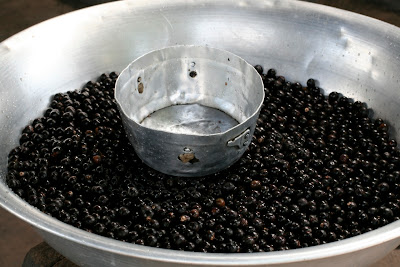Hippocrates, father of modern medicine, is said to have sited his hospital close to a stream to guarantee a constant supply of watercress. Recently it has gone from side dish to potential superfood thanks to its high vitamin and mineral content and potential anti-cancer properties.
Watercress (
Nasturtium officinale) is a cruciferous vegetable related to mustard, cabbage and broccoli and has a distinctive tangy, peppery flavour. It grows naturally in shallow, clean streams and is now widely cultivated in Europe and the US. Eaten fresh in a salad or as a soup, watercress is delicious enough to make it onto any plate, superfood or not!
The
newspapers today (26 Sep 2010) are full of the news that a compound in watercress can inhibit the growth of breast cancer. According to a
University of Southampton study, phenylethyl isothiocyanate (PEITC) blocks the function of a protein (Hypoxia Inducible Factor or HIF) produced by breast cancer cells that triggers the growth of new blood vessels around a tumor. By suppressing the protein the chemical effectively starves tumors of nutrients and oxygen.
What is exciting about this study is that is shows the positve effects of watercress in vivo rather than in a laboratory test tube. During the research breast cancer survivors fasted and then consumed a bowl of fresh watercress (an 80g serving). Blood tests showed that not only did PEITC show up in the test subject's blood for 24 hours after consuming the watercress but that function of HIF was measurably affected. With breast cancer affecting one in nine women in the western world this could a significant piece of research (
see caveat below).
A 2007
study published in the The American Journal of Clinical Nutrition is one of several previous studies to find that watercress has anti-cancer properties, especially in smokers. The research found that consuming 85g of fresh watercress a day reduced DNA damage in white blood cells (lymphocytes) by 22.9% and made cells more resistant to future DNA damage. Since DNA damage to blood cells is a generic measure of cancer risk this research, again involving real people eating fresh watercress, is potentialy momentous (
see caveat below).
Caveat: Both pieces of research metioned above involved small study groups and were funded by
The Watercress Alliance, a group of British watercress growers. The Daily Telegraph's Food Doctor has a decent
discussion of what that means. Studies funded or "sponsored" by a company or organisation in this way are not automatically biased but should be analyzed in more detail than genuinely independent research.
Cancer Research UK's Dr Anthea Martin had this to say about the 2010 study; "
while the results of this study are interesting, it involved a relatively small number of people. Larger studies are needed to determine whether the effects of watercress on cells seen by the researchers translate into a decreased risk of developing cancer".
The potential anti-cancer activity alone is, if proven by further research, enough to put watercress on the superfood list. Luckily watercress, for so long relegated to garnish status, is also a nutritionally dense food packed with antioxidant vitamins and minerals. The full nutritional breakdown for the fresh plant can be seen on the Nutrition Data website
here.
A 34g (one cup serving) of raw watercress contains only 4 calories but provides:
Vitamin A: 22% RDI
Vitamin C: 24% RDI
Iodine: 90% RDI (
source)
It does not, according to Nutrition Data, contain much zinc, fibre or folate and only moderate levels of the B vitamins and iron (less than 5% RDI). This does not tie in with the commonly reported "facts" but the ND figures come straight from the
USDA National Nutrient Database. The Watercress Alliance has its own
watercress nutritional analysis on its website with rather higher RDI levels (for an 80g serving; a lot of watercress).
On balance, fresh watercress is a low calorie, nutrient-rich food full of antioxidants that should be a regular part of your balanced diet. Smokers or former smokers should go further and consume watercress as often as possible. If its anti-cancer properties are proven in further independent studies watercress will shoot up the superfood listings.
SUPERFOOD RATING 6/10.
RDI: Recommended daily intake.
Note: Wild watercress can can attract the liver fluke (Fasciola hepatica) which causes quite serious liver disease. The basic rule about picking the wild plant is to avoid it if there are cattle or sheep in the vicinity and not to pick watercress growing in water that you wouldn't drink. Always wash all watercress well, even if shop bought.








